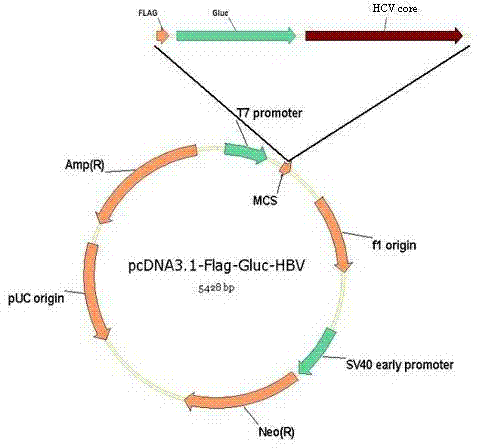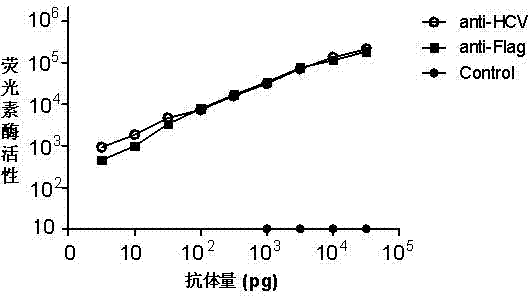Method for detecting hepatitis C virus antibody in serum
A hepatitis C virus and serum technology, applied in the biological field, can solve the problems of low sensitivity and specificity, unable to diagnose and treat, unable to reflect the changes of hepatitis C virus antibody, etc., and achieve the effect of high sensitivity and specificity
- Summary
- Abstract
- Description
- Claims
- Application Information
AI Technical Summary
Problems solved by technology
Method used
Image
Examples
Embodiment 1
[0021] Example 1. Taking the detection of hepatitis C virus core antibody in serum as an example, the following technical scheme is formulated.
[0022] Step 1. Construction of recombinant plasmid: Design and synthesize a primer pair (upstream primer: 5' AGCACAAATCCTAAACCTC 3', downstream primer: 5' AGCGGAGACCGGGGTGGGG 3') based on the hepatitis C virus core antigen sequence (Genbank #AF177036.1) to obtain DNA from hepatitis C patients Viral RNA extracted from whole blood was used as a template to amplify the hepatitis C virus core antigen gene (HCV core) and cloned into T vector for sequencing verification. Use the pGluc-basic (NEB product) plasmid as a template to amplify the Gaussia luciferase (Gluc) gene fragment by PCR, and artificially add the nucleotide sequence corresponding to the FLAG protein at the 5' end of the primer, and clone the amplified FLAG-Gluc Into the pcDNA3.1 vector, and at the same time clone the hepatitis B virus core antigen gene from the T vector ...
Embodiment 2
[0026] Example 2. The dose effect between the antibody and the activation level of the reporter gene: the activation level of the reporter gene was detected by the scheme in Example 1 with serially diluted HCV antibody (Abcam product) and Flag antibody respectively, and the results were as follows figure 2 As shown, it is suggested that there is a linear dose effect between the activation level of the reporter gene and the amount of antibody, which can be used for quantitative detection of antibody.
[0027] Fang Hui
[0028] A method for detecting hepatitis C virus antibody in serum
[0029] 3
[0030] 1
[0031] 8
[0032] PRT
[0033] Artificial sequence
[0034] 1
[0035] AspTyrLysAspAspAspAspLys
[0036]
[0037] 2
[0038] 570
[0039] DNA
[0040] Artificial sequence
[0041] 2
[0042] agcacaaatcctaaacctcaaagaaaaaccaaaagaaacaccaaccgtcgcccacaagacgttaagtttccgggcggcggccagatcgttggcggagtatacttgttgccgcgcaggggccccaggttgggtgtgcgcgcgacaaggaagacttcggagcggtccc...
PUM
 Login to View More
Login to View More Abstract
Description
Claims
Application Information
 Login to View More
Login to View More - R&D
- Intellectual Property
- Life Sciences
- Materials
- Tech Scout
- Unparalleled Data Quality
- Higher Quality Content
- 60% Fewer Hallucinations
Browse by: Latest US Patents, China's latest patents, Technical Efficacy Thesaurus, Application Domain, Technology Topic, Popular Technical Reports.
© 2025 PatSnap. All rights reserved.Legal|Privacy policy|Modern Slavery Act Transparency Statement|Sitemap|About US| Contact US: help@patsnap.com


